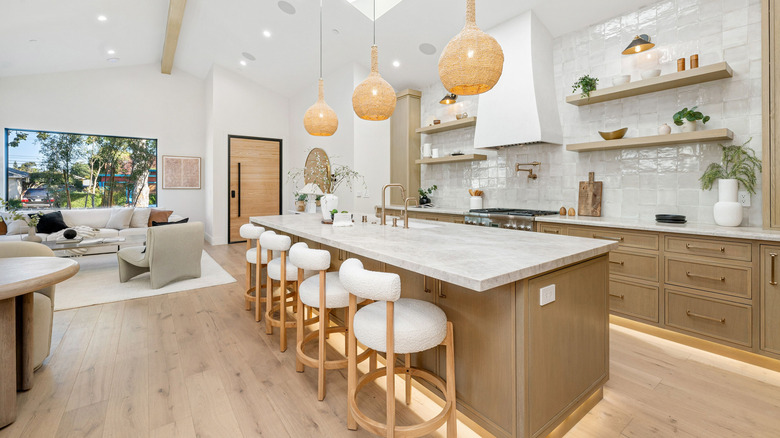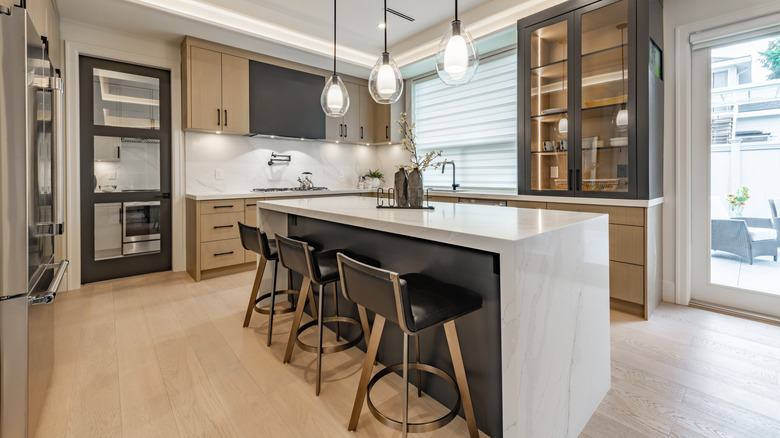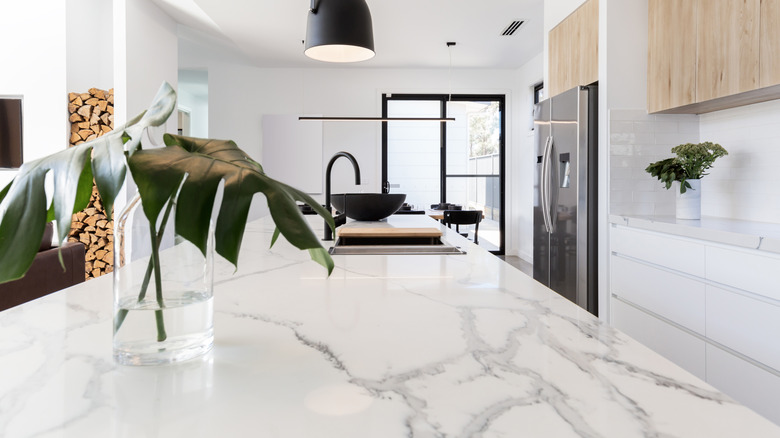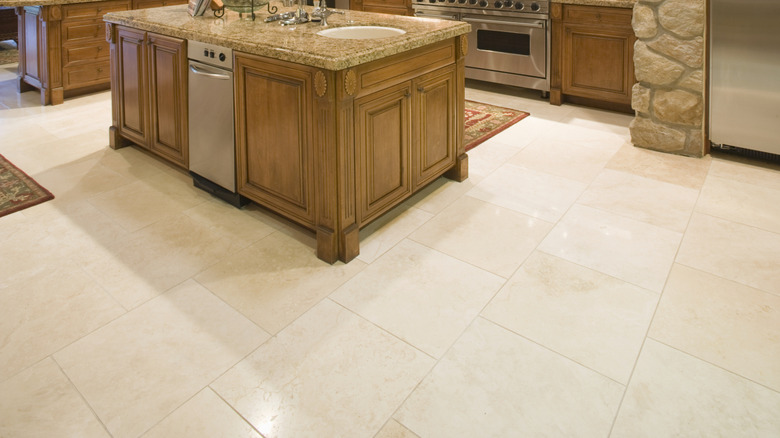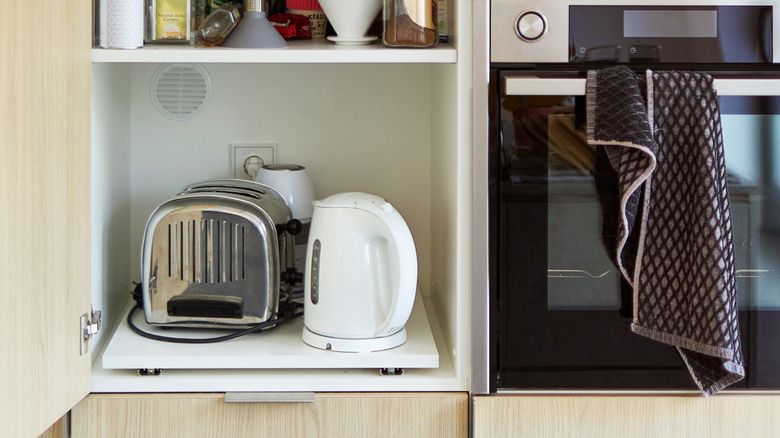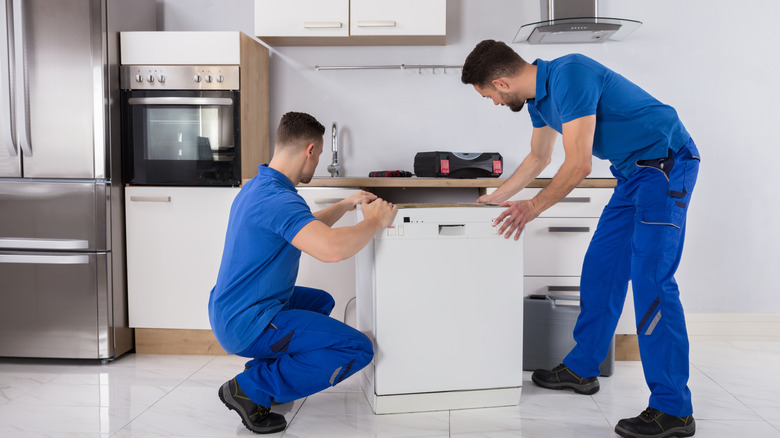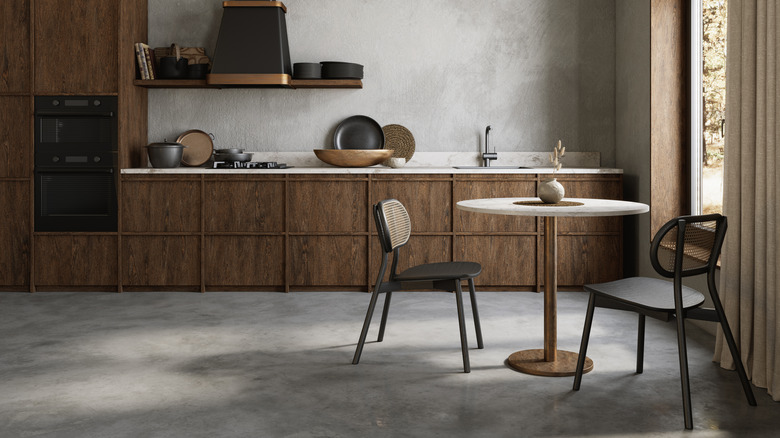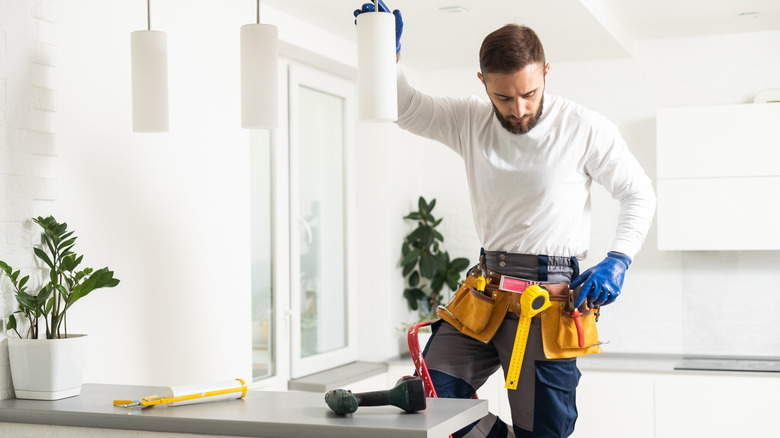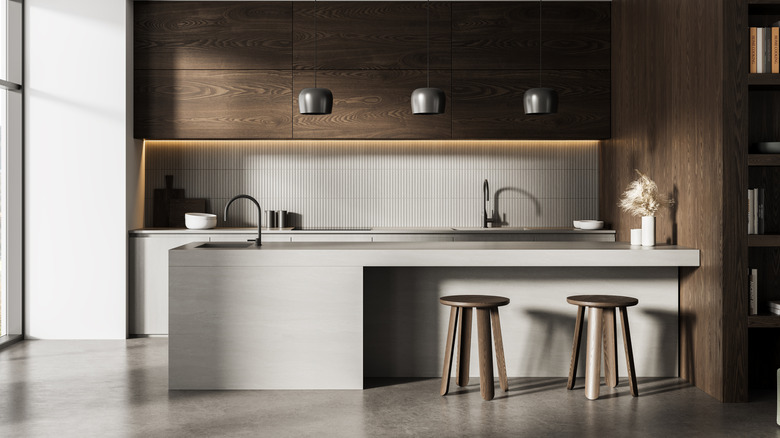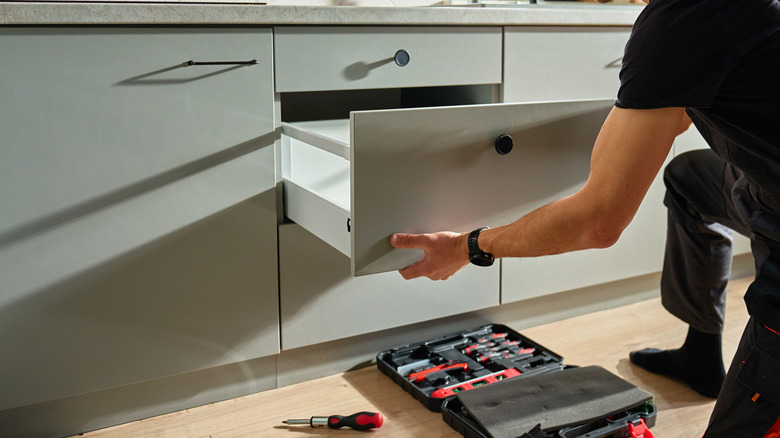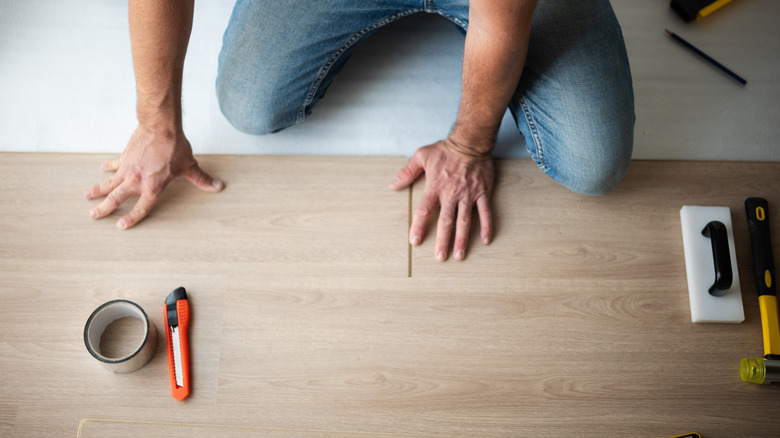12 Kitchen Upgrades That Are A Total Waste Of Cash, According To HGTV's Mike Holmes
Kitchen renovations are no joke, and they can certainly be pricey. However, there are a few ways to ensure your investment doesn't go to waste. From the choice of materials to the layout itself, there are countless costs to consider. If you're feeling overwhelmed by the endless list of decisions, take advice from a pro. Mike Holmes is an HGTV star and building expert, which makes him the perfect resource for all things home improvement.
You might have some eye-catching features in mind, but each upgrade comes with pros and cons. There are certain kitchen updates that may seem like a good idea initially, but they are much different in practice. Mike Holmes has experience in every kind of kitchen renovation, and he's learned what will and will not hold its value. If you want to make the most of your investment and design a space that will stand the test of time, consider these kitchen upgrades that are a waste of money, according to HGTV's Mike Holmes.
Creating an open concept space without proper inspections
Having an open kitchen is the modern standard, so it can be tempting to knock down a wall in order to create an open concept space. However, this can be a costly mistake if you're not 100% sure what your walls are hiding. Holmes writes on his website, Make It Right: "Many homeowners have their kitchen renovated in order to make it larger or open concept. Unfortunately, they sometimes remove load-bearing walls in the process. This compromises the structure and it isn't long before the cracks start to show." In another post, he doubles down by writing: "Creating an open concept space in an area that wasn't initially designed for it comes with its own set of challenges. Some walls hide ductwork and electrical runs – and by tearing down those walls, you'll need to find other routes for them."
Beyond the logistics of designing an open concept kitchen, there is also a question of whether it is the right layout for your space. Holmes argues that this floor plan might not be ideal for every lifestyle. He writes, "Open concept kitchens are a popular choice — but before you knock down any walls to open up your space, think about how you use your kitchen. Do you keep things neat and clean enough that you can have your kitchen on display at all times?" You might want to consider an option in between an open and closed floor plan, like a "broken floor plan." This method involves utilizing dividers rather than putting up (or taking down) entire walls. Discover the difference between open and broken floor plans (and why broken is trending).
Opting for 100% natural hardwood flooring in your kitchen
Although hardwood is beautiful, your kitchen may not be the best place to lay this pricey and fragile material. Holmes explains why on Make It Right: "Well, wood is prone to moisture damage and can be marked and dented when you drop something. Wood flooring is inviting but you should think twice about using it on the kitchen floors where high traffic and water can damage the finish. This will lead to early failure." You should feel free to get messy and make mistakes in your kitchen — including dropping pans and spilling liquids. However, hardwood floors can swell and warp from moisture, as well as dent easily.
If durability is your goal, it might be time to say goodbye to traditional hardwood floors, as other kitchen trends are taking over. Homeowners are prioritizing longevity and resilience, leading to the rise of laminate and vinyl flooring. Even engineered wood flooring doesn't hold up as well as laminate. Another enduring option is porcelain tile, which has an absorption rate of less than 0.5%, making it highly water resistant. You can even find porcelain tile that mimics the look of wood beams. Keep in mind that if your kitchen is located on an upper floor, you may need structural reinforcement to install porcelain tile.
Getting sucked into the hype of marble countertops
It's no secret that marble countertops are a sought-after surface. However, Holmes has a few valuable warnings to share before you invest in this pricey material. He explains on Make It Right: "Marble countertops offer elegance and sophistication to any kitchen or bathroom. Marble's distinctive veining and natural variations make each piece unique. However, marble is softer than granite and quartz, making it more susceptible to scratching and staining. It also requires frequent sealing. Marble is one of the more expensive materials, and when left untreated and exposed to the elements will darken over time." Holmes also almost exclusively uses quartz countertops in his show, and he even opted for this manmade alternative to marble in his own home. There are several reasons why quartz is preferred by many designers — including Holmes.
Quartz won't show wear and tear the same way natural stone can, and it is more affordable to install. Modern quartz countertops come in a wide range of designs and finishes, which means you don't need to worry about sacrificing the visual variation of natural stone. You can find quartz with realistic veining that mimics the striations of real marble, as well as colorful options like green and blue. The way that manufactured stone technology has progressed, you can capture your desired look while ensuring a more resilient and durable surface. These are the most popular quartz countertop brands and which to consider for your home.
Investing in a real stone wall before considering the maintenance
Although Holmes isn't against the aesthetic value of real stone walls, he urges homeowners to be well aware of their high-maintenance nature. If you don't want to be bothered with frequent cleaning and resealing, a manufactured alternative is a more suitable (and cheaper!) option. He writes on Make It Right, "Exposing a stone wall is a great way to add character and texture to a space. It provides a natural, rustic look with a wow factor. However, it can be tricky to install, unless you are using a manufactured stone veneer. Also, stone can collect dust and may need sealing. The look is amazing but just make sure you do your research to see if the right fit for you!" This is another case of low-maintenance versus authentic materials, and it all depends on your unique needs.
Just like the marble and quartz countertop battle, the same argument applies to stone wall features. Not only does real stone require more maintenance, but the construction is time-intensive and should be done by a skilled professional. One way to add stone-inspired touches throughout your cooking space is to install a faux stone backsplash. For example, this GenStone Faux Stacked Stone Panel is an affordable way to try out the look. This will give you a sense of whether you like the appearance of a stone accent wall before committing to the renovation. You can also opt for these Concord Wallcoverings Retro-Art 3D Faux Stone Wall Panels if you prefer a more irregular, modern look.
Breaking the law by installing an appliance garage the wrong way
An appliance garage can be a risky investment, especially if you don't consult a licensed electrician. In fact, it can be an illegal mistake. Holmes explains on Make It Right: "I get some people don't like the look of kitchen appliances out in the open, cluttering up your space. So if you're thinking of getting an appliance garage, make sure it's done right. It is against the law to install an electrical outlet within a kitchen cabinet." He goes on to explain that an appliance garage can be a fire hazard if you were to plug in an appliance prior to closing the door. This is why a relay device is essential. After shutting the door, the receptacle needs to be able to de-energize for safety. You should not attempt this electrical project at home unless you're a professional.
The value of an appliance garage isn't just in the appearance. If you don't want to waste your money on this upgrade, it's crucial to consider the functionality in addition to the aesthetics. Consider adding practical accessories like lazy Susans or custom shelving to enhance the value. If you're wondering which appliances can be stored inside, the answer depends on what will benefit your lifestyle. For an appliance garage that you access every day, you can store items like coffee pots and toasters. If you don't need to use it every morning, store bulkier appliances like juicers or hand mixers.
Buying appliances before installing kitchen cabinetry
It can be tempting to order your appliances as soon as you start your kitchen renovation, but it will likely cost you more in the long run. If you don't have your cabinets installed, you might get stuck with appliances that don't fit your space. Holmes writes on Make It Right: "The general rule is to install the kitchen cabinets before you order your appliances as you want to ensure your measurements are correct and that everything is going to fit." This is especially essential if you are planning to reconfigure the layout of your kitchen and position of appliances, rather than simply replacing what you already have.
While Mike Holmes' advice to never order appliances before your cabinetry holds true, many renovation experts suggest designing and fitting both together for a seamless result. Planning appliances and cabinetry in tandem ensures perfect sizing and clearance. In fact, Holmes himself is a strong advocate for custom cabinetry, emphasizing precision and quality craftsmanship, as mentioned in a recent "Holmes on Homes" Make It Right post: "We brought in quality custom cabinetry and new countertops — expertly measured and installed to fit perfectly." Coordinating both elements early can help you achieve a cohesive, functional kitchen design.
Laying natural stone floors like slate, limestone, or marble
Holmes is well aware that homeowners are after a luxurious look, but certain surfaces are not worth the price tag. On Make It Right, he explains his particular aversion to stone flooring in the kitchen: "Natural stone is often what I hear homeowners ask for. They are not a budget-friendly option though. Slate, limestone, and marble are popular choices, but they are also expensive and heavy. Natural stone is porous and needs to be sealed every couple of years." Even if you are careful with your floors, Holmes explains that seemingly innocent liquids like wine, lemon juice, vinegar, and other high-acidity beverages can actually eat away at the surface.
Already mentioned as hardwood alternatives above, porcelain tile and luxury vinyl can also stand in for natural stone, while maintaining a similar sense of elegance. Focus on design details that evoke the same tactile quality as stone. Choose flooring with veining or a matte finish to mirror the depth of natural materials, and use large-format tiles to create a seamless, high-end look. Pair these flooring alternatives with soft lighting and marble-inspired hardware for a luxurious look that is affordable, easy to achieve, and doesn't need to be treated with kid gloves.
Trying to save money with non-LED kitchen lighting
Sometimes trying to cut costs can actually hurt your wallet later on. Holmes tells readers on Make It Right why LEDs are well worth the upfront investment, versus inefficient alternatives: "LEDs can be used on dimmers and use about 20% less energy. You can also get LEDs for under cabinet lighting. LEDs may cost more, but it's worth it. The money you save on energy (not having to buy more bulbs and benefits to the environment) doesn't compare." He finishes by explaining, "When you switch to LEDs, you are helping the environment, your home, and your wallet."
LED bulbs have come a long way, and smart options now combine energy efficiency with advanced features that make saving energy easier than ever. "Smart" means the bulbs can be controlled remotely via an app or voice assistant, allowing you to adjust brightness, color, and schedules without touching a switch. Wirecutter found that the WiZ LED Smart Light Bulb is the best option. In fact, CNET also recommends this top-performing bulb for everyday use. If you have vintage lamps or pendant lights, this is how to tell what LED light bulbs are compatible with classic fixtures.
Falling for the contemporary appeal of concrete floors
Concrete is another kitchen flooring choice that Holmes is highly critical of. He lists several reasons why you should reconsider this expensive choice on Make It Right: "If you like the industrial look, you may be considering concrete flooring. It's not a practical choice for most renovations because it is very heavy. This is because of the minimal depth required to pour a solid concrete floor that won't crack or crumble." Because of the weight, Holmes tells homeowners that your floor may require a specific joist strength for a safe and stable installation.
If you want an industrial-style floor without concrete, there are plenty of creative options. Stained or reclaimed hardwood with gray or weathered tones can evoke a factory feel while adding warmth (though, as discussed, hardwood has its downsides). Terrazzo or epoxy floors offer a polished, durable surface with customizable patterns reminiscent of industrial spaces. Even large-format ceramic or porcelain tiles with concrete stone-like finishes can create a raw, urban look. Pairing these floors with exposed pipes, matte metals, and minimalist furniture can complete the industrial aesthetic without relying on actual concrete.
Choosing cheap new cabinets instead of custom alternatives
Holmes doesn't deny that custom cabinets are pricey, but he also believes that cheap new cabinets can be a waste of money due to several pertinent issues. He writes on Make It Right: "First off, let me be clear — custom cabinets cost more upfront. That's a fact. But in reality, cheap, mass-produced cabinets will cost you more in the long run. They're often made with particleboard or MDF and low-grade hardware. After a few years of use, they start to sag, peel, or fall apart. And then what? You're paying again to fix or replace them." Holmes emphasizes that investing in quality from the start saves both money and frustration over time. As mentioned above, his renovations have proven time and time again that well-made custom cabinets not only last longer, but also provide a better fit, finish, and overall aesthetic.
Custom cabinets offer endless opportunities to enhance the value of your kitchen. Consider incorporating built-in organizers, pull-out pantry shelves, or deep drawers for pots and pans to maximize storage. Integrated lighting, soft-close hardware, and hidden compartments are also great additions. Panel-ready appliances might also be a good option for your kitchen. These appliances are designed to accept custom cabinet fronts so they blend seamlessly with the surrounding cabinetry. Custom cabinetry allows you to perfectly match these panels to the rest of the surrounding storage.
It's a waste to upgrade finishes before prioritizing the must-haves
When upgrading your kitchen, it's crucial to determine your priorities before jumping into the remodel process. Otherwise, you could end up spending money on all the wrong things. Holmes explains on Make It Right how to avoid running out of money before addressing the most important issues: "Before you start thinking about your finishing selections, pay attention to areas of your kitchen that you really want to change. If you've got a problem that really drives you crazy — like not enough space to prepare meals, make sure you're addressing that first — if you don't, you'll probably end up regretting it. This is also a really good time to address features that you've always wanted in your kitchen." Holmes notes that everything on your wishlist might not fit into your budget, but splurging on one must-have item can be worth it.
Finishes tend to be more cosmetic than functional, meaning they usually don't affect the workflow of a kitchen in the way that things like surfaces, appliances, and layouts do. When creating a checklist for your kitchen renovation, start by making a list of everything you felt your old kitchen lacked. Then, create a budget that you feel comfortable with – and add 20%. Even if you plan on being frugal, there will almost always be hidden costs, and you don't want to be caught with no extra cash. Next, determine what kind of layout makes sense for your lifestyle. Explore options like galley kitchens, U-shapes, L-shapes, and one-wall kitchens. Once you've covered all of your practical bases, then you can start browsing finishes as a final planning step.
Only tiling the floor up to the cabinets
If you're tiling your kitchen floor, this upgrade can backfire if you lay the tile all the way up to your cabinets. Holme explains why on Make It Right: "When putting in a new floor, a lot of homeowners leave the existing cabinet boxes in place and tile up against them. This is not a good idea! If there is ever a leak underneath the sink or the dishwasher leaks, you won't see it and that water will end up going downstairs." Water damage can completely ruin your brand-new renovation and create a very expensive problem in the future.
Holmes recommends having a meeting with your installer to discuss the importance of replacing the entire floor, and that goes for the floor that stretches under the cabinets. He notes that writing this into your contract is essential. You may need to change out your kitchen cabinets, but it's well worth it to ensure an even floor that won't get water trapped underneath. Other key considerations before installing your new floor include checking for high and low spots on your floor using tools such as a straightedge, level, and feeler gauge. Even small irregularities over a quarter inch require leveling, and neglecting moisture testing can compromise the entire project.

